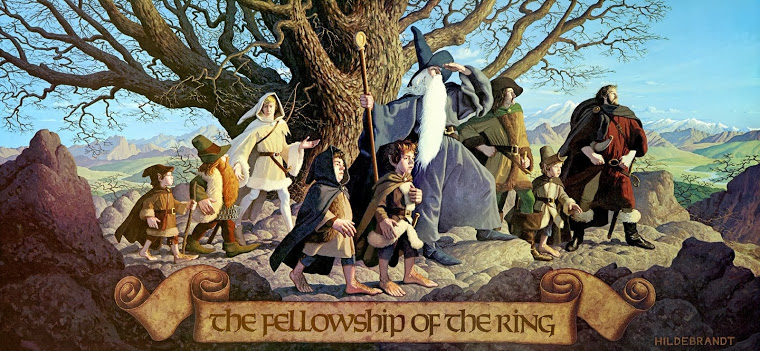Excerpts from this How Stuff Works article by Marshall Brain, reveal the interesting history behind The Brothers Hilderbrant’s work for J.R.R. Tolkien.
Ian Summers, the art director for Ballantine Books needed a set of 14 illustrations for the 1976 Tolkien Calendar. Ian describes the scene of his first meeting with the Brothers Hildebrandt in this way:
“In the reception area stood a pair of identical twins, bearded, wet (it was a snowy day in February), with paint-covered jeans, thick eyeglasses, and a kind of endearing attitude. I searched for their portfolios. There were only two dark-green plastic garbage bags in the corner, seemingly left behind by the night crew. I suggested that they come back when they had their portfolios with them and to make an appointment. One of them said, “Hey, man. Pictures. Tolkien pictures. We make ’em.” Each reached for a garbage bag and emptied it onto the reception room floor. Greg was on his knees smoothing out crumpled pieces of vellum with exquisite pencil drawings based on “The Lord of the Rings.” I was enthralled. One might say my jaw dropped. I had been searching for unique artists to create the Tolkien calendars. I knew I had found them… Within a week, papers were signed and I had commissioned the brothers to create fourteen paintings.”
[Source: Greg and Tim Hildebrandt, The Tolkien Years]In the case of the Tolkien illustrations, many of the basic notions and some of the details come from the word-pictures that Tolkien paints. In the forward to the book, Tolkien paints a picture of hobbit architecture:
The craft of building may have come from Elves or Men, but the Hobbits used it in their own fashion. They did not go in for towers. Their houses were usually long, low, and comfortable. The oldest kind were, indeed, no more than built imitations of smials, thatched with dry grass or straw, or roofed with turves, and having walls somewhat bulged. That stage, however, belonged to the early days of the Shire, and Hobbit-building had long since been altered, improved by devices, learned from Dwarves, or discovered by themselves. A preference for round windows, and even round doors, was the chief remaining peculiarity of hobbit-architecture.
The Hildebrandt brothers spent a lot of time interpreting these descriptions and experimenting with various representations. In addition, Tolkien gave some instruction into the appearance of things after he wrote his books. For example, in a letter to the Houghton Mifflin company in 1938, Tolkien elaborated on the appearance of hobbits:
“I picture a fairly human figure, not a kind of ‘fairy’ rabbit as some of my British reviewers seem to fancy: fattish in the stomach, shortish in the leg. A round, jovial face; ears only slightly pointed and ‘elvish’; hair short and curling (brown). The feet from the ankles down, covered with brown hairy fur… Clothing: green velvet breeches; red or yellow waist-coat; brown or green jacket; gold (or brass) buttons; a dark green hood and cloak (belonging to a dwarf)…. Actual size…say about three feet or three feet six inches… But since leathery soles, and well-brushed furry feet are a feature of essential hobbitness, he ought really to appear unbooted, except in special illustrations of episodes.” [Source: “The Letters of J.R.R. Tolkien” p. 35 Letter # 27 to the Houghton Mifflin Company]
However, the brothers also have some liberty as illustrators. Tim notes…
“When reading Tolkien’s text, Greg and I questioned what it would look like if Gandalf’s eyebrows stuck out past his hat. We decided not to follow his text literally because his description of Gandalf’s eyebrows would have made them almost a foot long.”
“Whenever we started working on a new character, we did dozens of drawings. These were quick sketches done without the use of models. Character studies defined movement and personality.”
“Our method is to create thumbnail sketches, then make costumes and photograph a model in the correct lighting.”
“People usually only see the finished product. They don’t realize the amount of work that is done before we even start the paintings. We did very elaborate, full-sized pencil drawings for almost all of our Tolkien work. We had to do them this detailed not only for ourselves, but for Ballantine, in order to get their approval and check for inaccuracies.”
“I can remember spending nearly a month painting all of the coins and jewels.” The fact that these paintings are so large and detailed means that everything takes longer. On the other hand, the size yields incredibly detailed illustrations.”
The article itself is fairly basic but offers some insights and images of the Hilderbrants’ illustration process. Presumably, their book, Greg and Tim Hildebrandt: The Tolkien Years probably goes into greater detail. While first editions can be found, few are inexpensive. However, Amazon offers a trade paperback reprint titled The Tolkien Years of the Brothers Hildebrandt. After a look at online preview pages, I might have to order a copy.
Discover more from
Subscribe to get the latest posts sent to your email.

One thought on “Hildebrandts on Illustrating Tolkien”
Comments are closed.